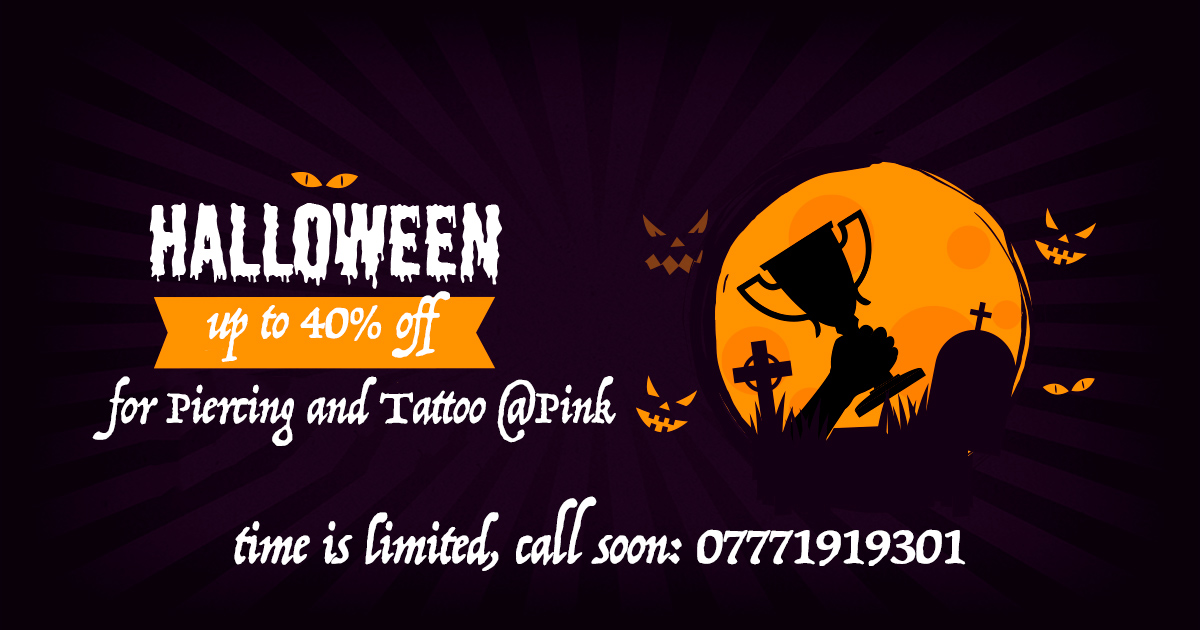The helix piercing is the undisputed icon of cartilage piercing—a versatile and elegant adornment that gracefully traces the upper curve of the ear. From a single, minimalist hoop that whispers sophistication to a stunning cascade of sparkling studs, the styling possibilities are endless. At Pink Tatpier, London’s premier piercing studio, we are masters in the art of the helix, ensuring perfect placement, a safe and precise procedure, and a beautifully healed result that becomes the cornerstone of your curated ear.
A helix piercing is more than just a piece of jewellery; it’s a statement of personal style. But to achieve that perfect look, the piercing must be performed with professional expertise. This guide is your complete resource for everything you need to know before taking the next step.
Explore our professional approach to helix piercings, get a transparent price for your appointment, discover the best jewellery for healing and style, and book online with London’s top ear curation specialists.
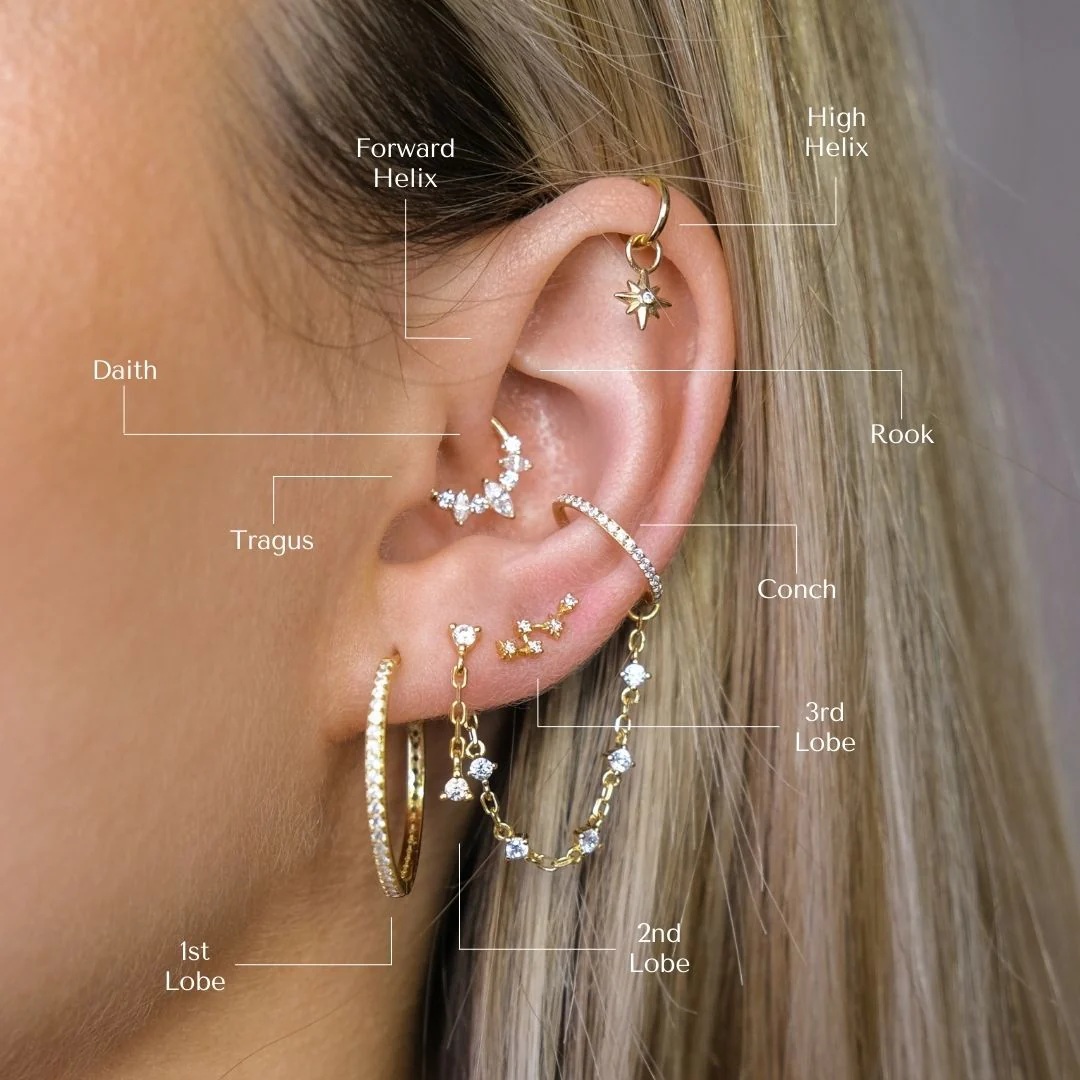
Helix Piercing
What is a Helix Piercing? Understanding the Placement & Variations
The “helix” refers to the outer, curled rim of cartilage on the upper part of the ear. A helix piercing can be placed anywhere along this ridge, offering a huge range of aesthetic possibilities.
The Classic Helix
This is typically a single piercing located on the upper-mid portion of the outer rim. It’s the most common placement and is perfect for being styled with either a stud or a hoop once fully healed.
Variations on a Theme: The Art of Curation
The true beauty of the helix lies in its potential for creating a unique, curated look.
- Double & Triple Helix: This is where two or three piercings are placed closely together, “stacked” along the helix ridge. This creates a beautiful, intentional look and is a very popular way to make a statement.
- Forward Helix (or Anti-Helix): This piercing is placed on the forward-facing part of the helix rim, just above the tragus. It’s a more unique placement that beautifully frames the front of the ear. (We have a dedicated guide for this specific piercing).
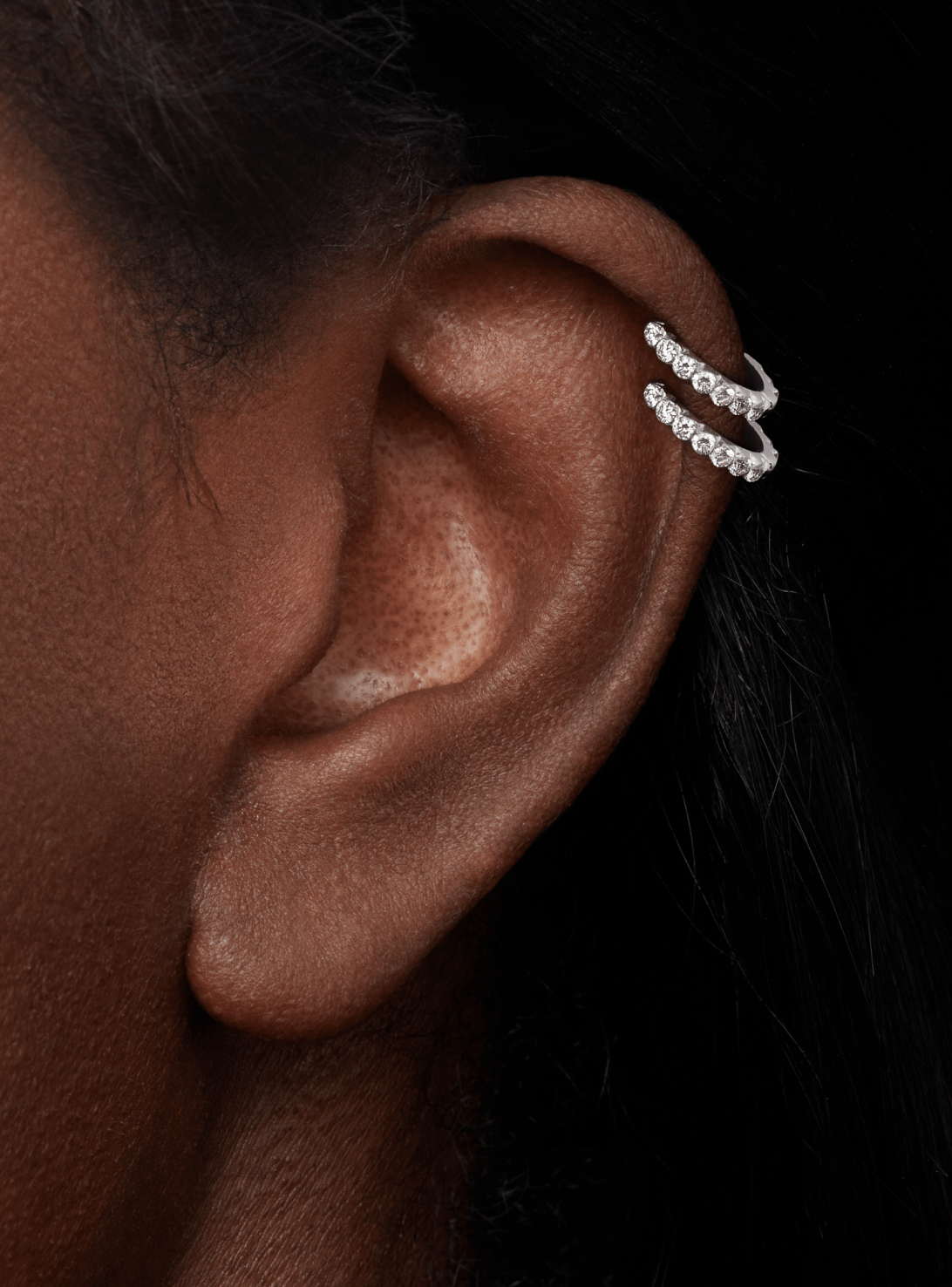
Helix Piercing
The Most Important Decision: Why You Must AVOID Piercing Guns for Cartilage
Before we go any further, we must address the most critical aspect of any cartilage piercing: the method. At Pink Tatpier, we are passionate advocates for client safety and education.
The Dangers of Piercing Guns
Piercing guns, often found in malls and accessory shops, are extremely dangerous and unsuitable for any piercing, especially cartilage.
- Blunt Force Trauma: A piercing gun does not use a sharp needle. It uses a blunt-ended stud to force its way through your tissue. This shatters the cartilage, causing significant and unnecessary trauma, which leads to prolonged healing, excessive pain, and a much higher risk of permanent scarring and keloids.
- Guaranteed Inaccuracy: These bulky guns cannot be precisely aimed, often resulting in crooked piercings that are impossible to style correctly with a hoop later on.
- Risk of Infection: Plastic piercing guns cannot be properly sterilised in a medical-grade autoclave. This creates a serious risk of transmitting bloodborne pathogens. The butterfly-back jewellery they use also traps bacteria and is notoriously difficult to clean.
The Professional Needle Advantage
We exclusively use a brand new, single-use, hollow, and razor-sharp needle for every piercing. This method is superior in every way:
- Precision: A needle allows for perfect, precise placement and angling.
- Minimal Trauma: It creates a clean, neat channel through the cartilage instead of shattering it, resulting in a much smoother, faster, and healthier healing process.
- Absolute Sterility: Every needle is pre-sterilised and single-use, eliminating the risk of cross-contamination.
Choosing a professional studio that uses a needle is the single most important decision for the health and beauty of your helix piercing.
The Helix Piercing Process: A Guide to Your Appointment
- Consultation & Curation Advice: We begin by discussing your vision. Are you planning a single piercing or a future project? We can help you map out the perfect placement.
- Jewellery Selection: You will choose your initial jewellery from our extensive collection of implant-grade, flat-back labret studs.
- Artistic Marking: Your piercer will carefully mark the placement, ensuring it is perfectly angled to sit flush with your ear. You will always approve the final mark.
- The Piercing Procedure: The piercing itself is very quick, performed with a smooth and professional technique to minimise discomfort.
- Aftercare Briefing: We provide you with a comprehensive aftercare plan to guide you through a successful healing journey.
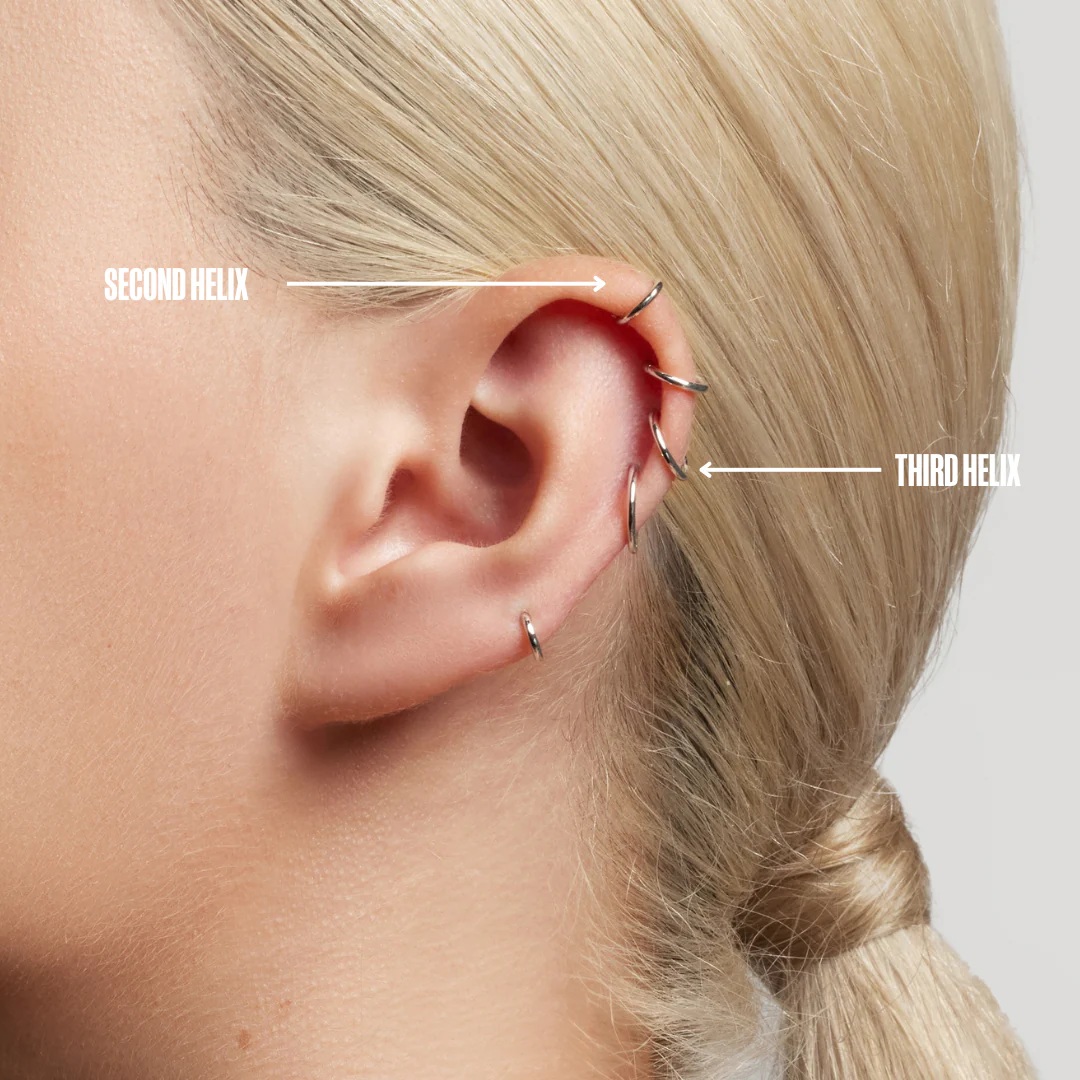
Helix Piercing
Helix Piercing Price, Pain & Healing: Your London Guide (September 2025)
Pain Level
For a cartilage piercing, the helix is considered very manageable. Most clients rate the pain at a 4-6 out of 10. You will feel a quick, sharp pinch that subsides into a dull ache. It is often less painful than thicker cartilage areas like the rook or daith.
Healing Time
Patience is essential. A helix piercing will typically take 6 to 9 months, and often up to a year, to heal fully. Its exposed position on the outer ear makes it very prone to being snagged by hair, glasses, or masks, which can cause irritation and prolong the healing process.
Cost of a Helix Piercing in London
Our pricing is transparent and charged per piercing, which is ideal for planning double or triple projects.
| Service | Price (GBP) | What’s Included |
| Helix Piercing Fee (per piercing) | £35 – £45 | A professional consultation, curation advice, marking, the sterile piercing procedure, and aftercare guide. |
| Initial Jewellery (Stud) | Starts from £20 | An implant-grade titanium flat-back labret stud. Price varies for solid gold and genuine gemstones. |
| Total Starting Price (per piercing) | From £55 – £65 | The service fee + the cost of your chosen jewellery. |
The Best Jewellery for Your Helix Piercing: A Style & Safety Guide
For Initial Healing: The Non-Negotiable Flat-Back Stud
There is a common desire to be pierced with or quickly switch to a hoop in a helix piercing. We must be clear: this is the number one cause of healing complications.
- Why a Hoop is Unsuitable for Healing: The curvature and movement of a hoop in a fresh, straight piercing channel cause constant irritation, friction, and pressure. This inevitably leads to painful irritation bumps, migration (the piercing moving), and can even cause the piercing to fail entirely.
- The Superior Solution: For the entire initial healing period, the only safe and appropriate jewellery is a flat-back labret stud. The flat disc on the back is comfortable, easy to clean, and minimises snagging, providing the stable environment your piercing needs to heal perfectly.
For a Healed Piercing: Hoops, Studs, and Chains
Once your piercing is fully healed (after 6-9+ months), the styling fun can begin! We can fit you for:
- Snug-fitting Hoops: Beautiful seamless rings or decorative clicker hoops for that classic helix look.
- Decorative Studs: You can keep the comfortable flat-back post and simply change the decorative end to any of our stunning options.
- Chains: Connect your helix to another piercing, like a lobe, for a dramatic and elegant draped look.
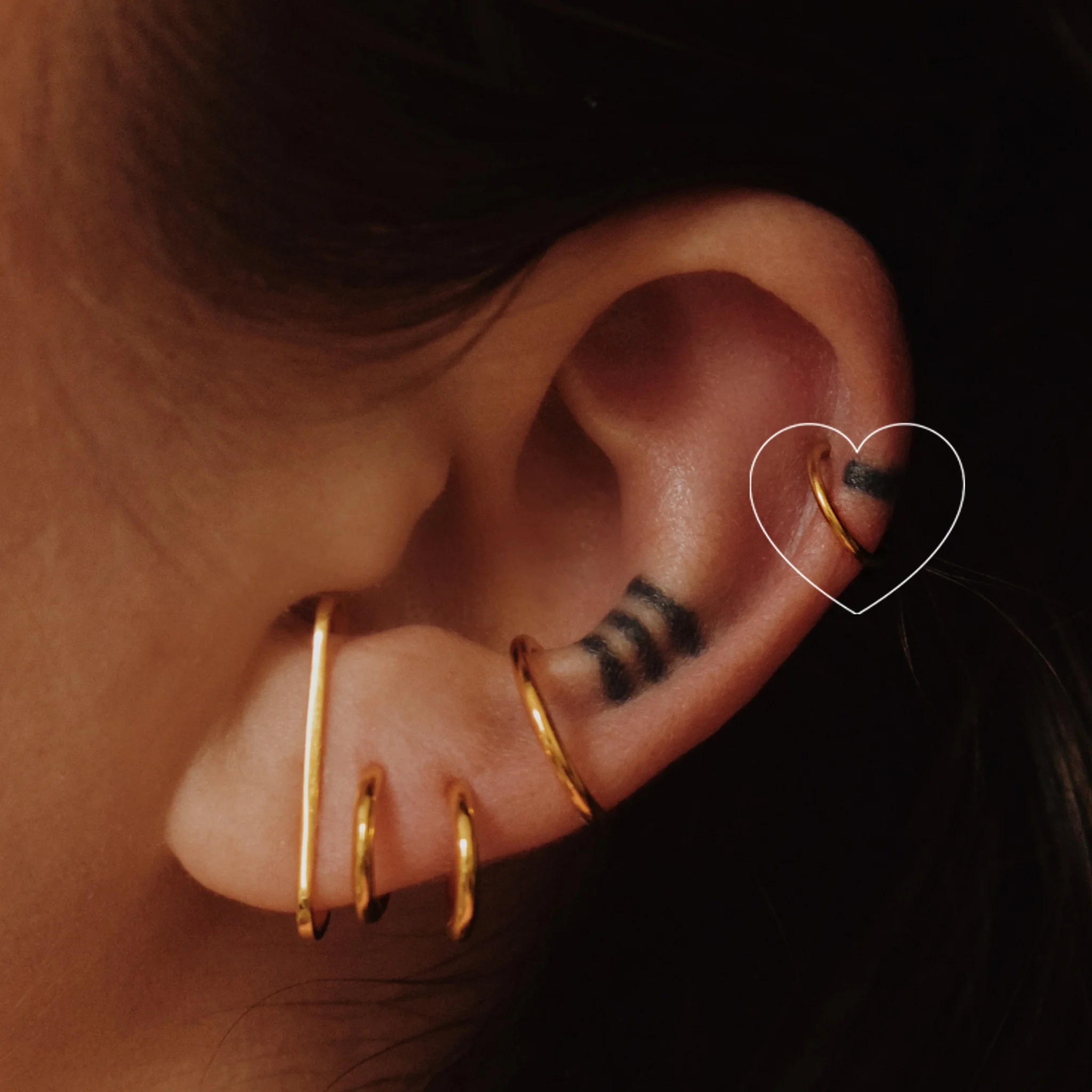
Helix Piercing
Professional Aftercare for a Happy Helix Piercing
- DO clean the piercing twice daily with a sterile saline solution.
- DO NOT sleep directly on your new piercing. This is the most common cause of irritation. Use a travel pillow and place your ear in the hole to avoid any pressure.
- BE VERY CAREFUL with hair, glasses, masks, hats, and headsets to avoid snagging the jewellery.
- DO NOT twist, turn, or play with the jewellery.
- DO consider returning for a downsize appointment after 4-6 weeks to have a shorter bar fitted once the initial swelling has subsided.
Frequently Asked Questions About Helix Piercings
1. Why can’t I get a hoop straight away? I see so many people with them.
You are likely seeing people with fully healed piercings. A reputable piercer will never use a hoop as initial jewellery in a helix piercing because it is not conducive to proper healing. The initial wait is worth it for a healthy, beautiful piercing for life.
2. What are the bumps on my helix piercing?
These are almost always irritation bumps, not infections. They are very common and are caused by trauma (snagging, sleeping on it), moisture, or low-quality jewellery. The key is to identify and eliminate the source of the irritation.
3. What’s the difference between a helix and a flat piercing?
A helix piercing is on the outer curled rim of the ear. A flat piercing is on the flat plane of cartilage inside that rim.
4. Can I get a double or triple helix at the same time?
Yes, if your anatomy allows for it and you are prepared for the intensive aftercare. Healing multiple piercings at once requires extra diligence to avoid irritation.
Begin Your Curated Ear Journey in London
A helix piercing is a beautiful and versatile way to express your style. Ensure it’s done safely, placed perfectly, and destined to heal beautifully by choosing a professional studio that puts your health and the art first.

